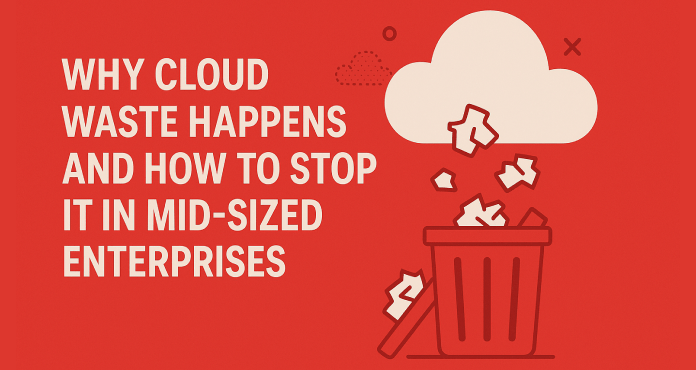
Introduction
The promise of cloud computing is irresistible for mid‑sized enterprises (MSEs): instant scalability, pay‑as‑you‑go pricing, freedom from on‑prem hardware, and faster time‑to‑market. Yet many organisations discover a different reality on their invoices—“cloud waste.” Gartner estimates that companies overspend 25‑35 % of their cloud budget on resources they never truly use.
Cloud waste is not limited to compute instances idling in the night. It also hides inside abandoned block storage, aged snapshots, forgotten demo environments, oversized Kubernetes nodes, unused Reserved Instances, and even SaaS subscriptions that no team touches anymore. As your company grows past a few hundred employees, these small inefficiencies snowball into six‑ and seven‑figure annual expenses.
In this article we explore the root causes of cloud waste, why mid‑sized organisations are uniquely exposed, and a practical playbook—complete with automated tooling—for eliminating wasted spend within one or two quarters. But we encourage you to read on, because each section will arm you with concrete tactics you can implement today.

1. What Exactly Is Cloud Waste?
| Type of Waste | Typical Triggers in MSEs | Hidden Impact |
|---|---|---|
| Idle or Zombie Resources | QA instances left running after a sprint; abandoned dev VMs | Pays for compute/network/storage 24×7 while producing zero value |
| Oversized Workloads | Lift‑and‑shift from on‑prem without rightsizing | Higher hourly rates + unnecessary reserved‑instance commitments |
| Shadow IT / Untagged Assets | Teams swipe cards for SaaS or spin up personal AWS accounts | Finance can’t trace cost drivers; governance & security risks |
| Orphaned Storage & Snapshots | Automated backups without lifecycle rules | Compounding GB charges every month |
| Mis‑aligned Purchase Options | Buying on‑demand where Savings Plans or RIs fit, or vice‑versa | Missed discounts up to 72 % |
Beyond these “usual suspects,” two emergent categories deserve special mention:
- Container Drift – Kubernetes clusters scale up for a traffic burst but never scale back, leaving nodes half‑empty yet fully billed.
- Managed Service Creep – Serverless functions, message queues, and AI APIs that cost pennies individually but explode with high‑volume event traffic.
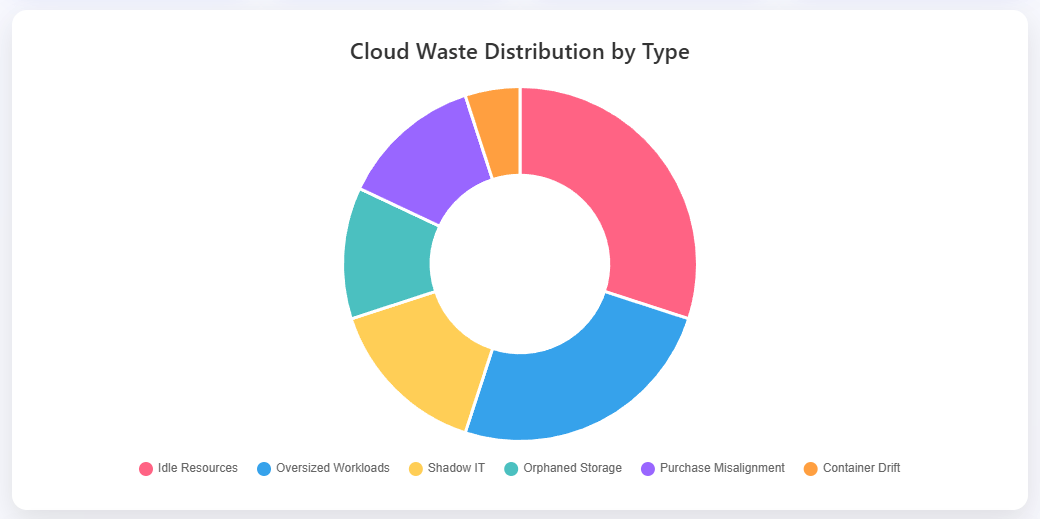
The SaaS Angle
Cloud waste frequently hides in Software‑as‑a‑Service subscriptions. The average 500‑employee company now pays for 231 separate SaaS applications, yet almost one‑third of purchased licences go unused. Neglected seats, premium plans bought “just in case,” and forgotten trials accumulate the same way idle VMs do—only the line item lands on a different invoice.
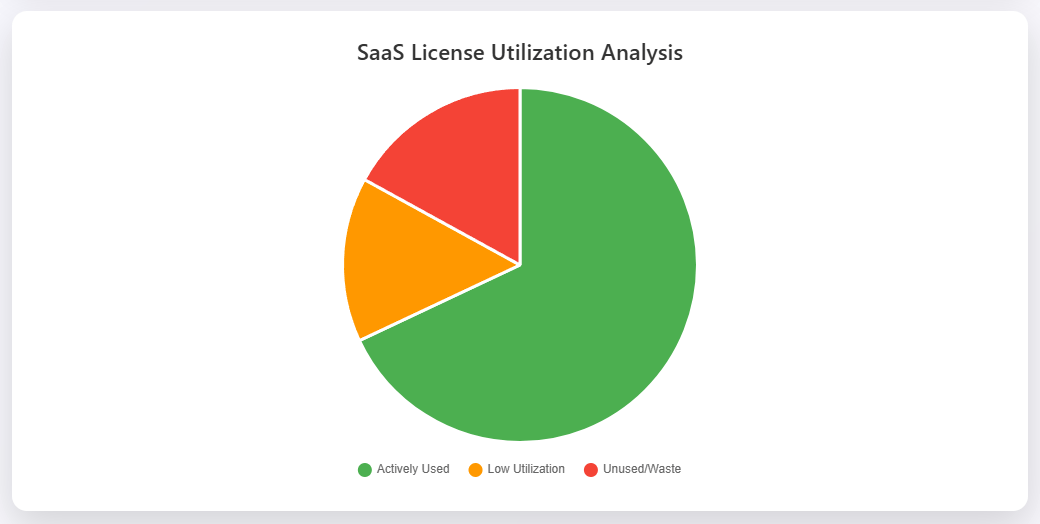
2. Why Mid‑Sized Enterprises Are Especially Vulnerable
- Fast‑Growing Teams – New projects spawn clouds of short‑lived resources that never get cleaned up.
- Lean FinOps Staff – MSEs rarely have a dedicated FinOps squad; cloud bills remain a black box.
- Hybrid Vendor Mix – A typical MSE now runs AWS, Azure, and a half‑dozen critical SaaS tools. Visibility fragments quickly.
- Budget Culture – Departmental budgets encourage “just in case” sizing so no one gets paged for running out of capacity.
- Tool Sprawl – Each team picks its own monitoring or IaC tool; no single pane of glass.
- M&A Hangover – Acquisitions bring duplicate cloud accounts and SaaS contracts that linger for months.
- Governance Lite – Policies exist on paper but enforcement lags because engineering speed > compliance bandwidth.
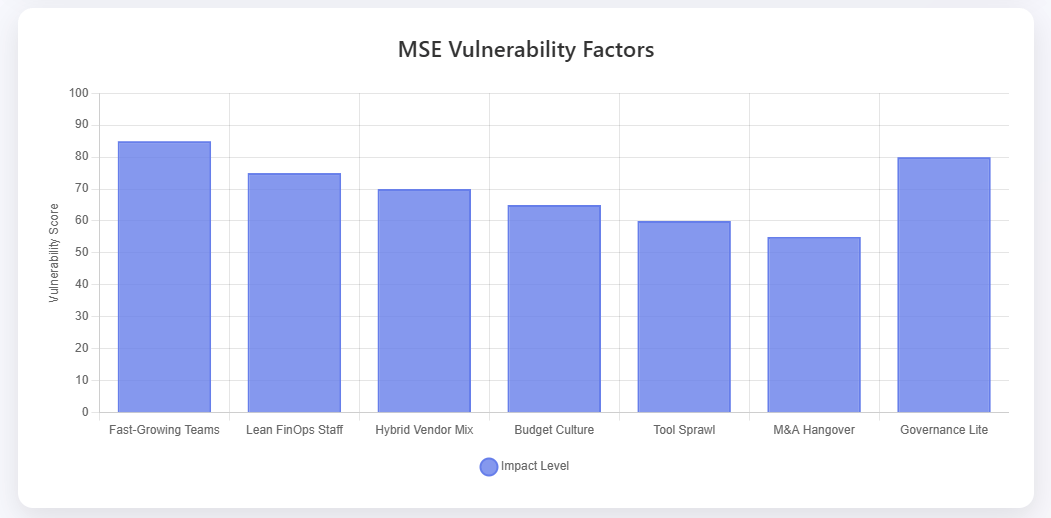
The net result is a perfect storm: rapid growth meets limited oversight. Unless leaders address cost hygiene early, waste compounds with every sprint and every new SaaS sign‑up.
3. Six Proven Tactics to Eliminate Cloud Waste
3.1 Gain 360° Visibility
“We first need clear visibility into both how much we’re spending and what resources we’re actually using.”
- Connect every AWS, Azure, GCP account and key SaaS application to a single dashboard such as Binadox Cloud & SaaS Utilisation.
- Enforce mandatory tagging (team, project, environment) so untagged spend never slips through reports.
- Adopt
terraform‑tag‑enforcementpolicies in CI/CD to block untagged resources before they reach production.
3.2 Continuous Rightsizing
- Analyse CPU, memory, and I/O trends weekly. Tools like Binadox Rightsizing recommend the smallest viable instance or DB class and project annual savings
- Archive or down‑tier cold object storage and older database snapshots.
- Run scheduled Lambda/Lite rules to verify Kubernetes
resourceRequestsalign with observed usage.
3.3 Automated Clean‑Up Rules
Automation beats good intentions. With Binadox Automation Rules, you can:
- Power off dev stacks outside business hours.
- Delete orphaned EIPs, snapshots, and load balancers after X days of inactivity.
- Trigger Slack alerts when a SaaS licence lies dormant for 30 days.
3.4 Smart Purchasing & Discounts
- Evaluate Savings Plans / RIs vs. Spot; mix for predictable and flexible workloads.
- Binadox Renewal Calendar warns of upcoming SaaS or reserved‑instance renewals so you can renegotiate or cancel.
- Use
compute‑savings‑plan‑coveragedashboards to ensure at least 70 % coverage of baseline compute hours.
3.5 Governance & FinOps Lite
- Establish a Cloud Cost Council—one IT lead + Finance + key product owners—to review anomalies flagged by Binadox Cost Explorer each month.
- Publish internal “golden metrics” such as cost per customer or cost per 1000 API calls to shift conversation from absolute spend to unit economics.
- Adopt policies from Basic Cloud Computing Terminology to standardise definitions across teams.
3.6 Measure & Iterate
- Set quarterly waste‑reduction KPIs (e.g., “cut idle EC2 spend 40 %”).
- Leverage Binadox reports to track baseline vs. target and broadcast wins company‑wide.
- Celebrate reclaimed budget by reinvesting part of savings into innovation sprints.
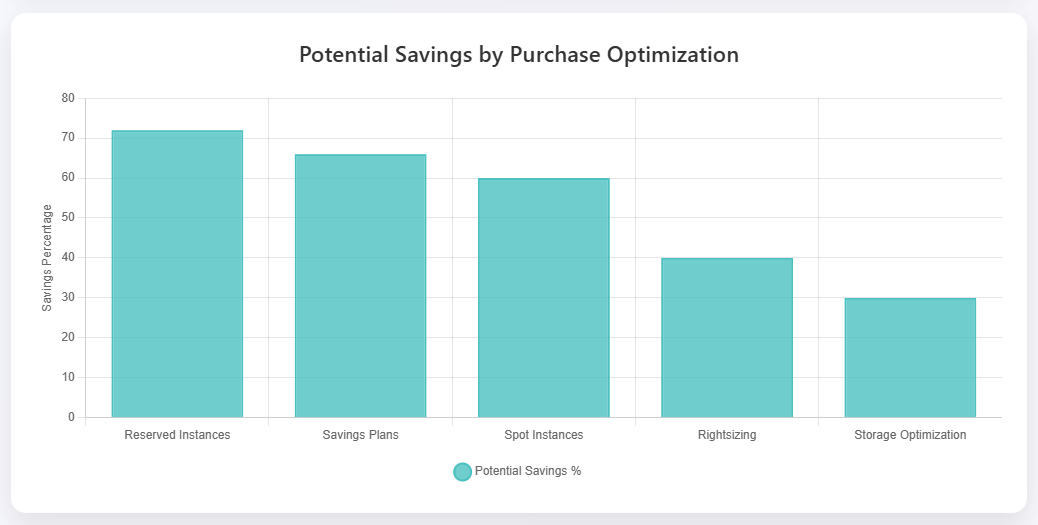
4. Hidden Costs Beyond Compute (The SaaS Dimension)
Cloud waste conversation often focuses on EC2, SQL databases, or S3—but SaaS waste represents an equally rich savings well. According to our analysis of 170 Binadox customers, the median MSE spends 22 % of its IT budget on SaaS. Of that sum, 28‑32 % funds licences with zero or low utilisation.
Key drivers of SaaS waste include:
- Auto‑renewal inertia – Contracts silently roll over and Finance pays the bill, assuming IT still needs the tool.
- Premium‑plan gravity – Teams pick the top‑tier plan to unlock one feature but ignore cheaper modular add‑ons.
- Shadow procurement – Individual engineers swipe a corporate card for a SaaS sidekick, duplicating a centrally managed tool.
- Local compliance – Duplicated contracts appear after global expansion because each subsidiary buys its own seats.
Binadox counters these issues with automatic licence utilisation tracking, user‑level engagement metrics, and a renewal calendar that surfaces contracts 60 days before notice periods.
5. Building a FinOps Culture in Mid‑Sized Teams
FinOps—short for “Cloud Financial Operations”—is less about spreadsheets and more about shared ownership of cloud value. For mid‑sized organisations it means empowering product managers and engineers to treat cost as a dimension of quality, just like security or performance.
- Make cost visible in the developer workflow. Add cost diffs to pull‑request checks so engineers see the dollars attached to their IaC changes.
- Run monthly “showback” sessions. Present team‑level cost dashboards and celebrate the biggest percentage drop, not just absolute savings.
- Gamify savings. Offer lunch‑and‑learn credits or swag for the squad that spots the most
zombie‑resourceseach quarter. - Tie OKRs to efficiency. Instead of “ship feature X,” aim for “ship feature X with less than $0.20 per daily active user hosting cost.”
- Create a lightweight cost champions network. One delegate per tribe keeps an eye on daily anomalies and raises PRs to remediate.
6. Implementation Pitfalls to Avoid
- Analysis Paralysis – Waiting for “perfect” tagging before starting any optimisation; begin with the 80 % you can tag today.
- One‑off Clean‑ups – Deleting idle resources once but forgetting continuous enforcement; automate or regress.
- Partial Visibility – Connecting only the production accounts; sandbox and lab accounts frequently hide the worst waste.
- Over‑commitment – Locking into 3‑year RIs for workloads that might be containerised next quarter.
- Ignoring Human Factors – Forgetting to train engineers about new policies (e.g., auto‑sleep hours) leading to frustration and manual overrides.
7. Future Trends: AI‑Driven Optimisation & Sustainability
The next wave of cost optimisation leverages machine learning to predict workload patterns and automatically adjust purchase commitments. Binadox’s Addition Advice engine already applies ML to surface “weak spots” in security and cost posture.
Meanwhile, ESG reporting pressures are pushing IT leaders to track carbon waste alongside dollar waste. Expect tooling to map grams CO₂ per workload and recommend greener regions or sustainable compute options.
8. Quick‑Start Roadmap for MSEs
| Week | Action | Outcome |
|---|---|---|
| 1 | Connect cloud & SaaS accounts to Binadox | Unified cost inventory |
| 2 | Tag audit + create missing tags | 100 % traceable spend |
| 3 | Enable Rightsizing & Automation Rules | First wave of idle shutdowns |
| 4 | Present FinOps snapshot to leadership | Budget‑backed optimisation plan |
| 5‑8 | Iterate: rightsizing, SaaS audits, purchase coverage tuning | Compound savings + cultural change |

9. Action Checklist
- Centralise all accounts (cloud + SaaS) in a single view.
- Enforce project/team/environment tags.
- Enable automated idle shutdown outside office hours.
- Schedule weekly rightsizing reports.
- Review Savings Plan coverage monthly.
- Publish cost metrics to engineering dashboards.
- Host a quarterly FinOps retro and share the wins.
Conclusion
Cloud waste is optional. Mid‑sized enterprises that combine visibility, automation, and governance typically reclaim 25-30 % of their cloud and SaaS spend within a single quarter—and some, like AcmeSoft, exceed 35 %. The sooner you identify idle and oversized resources, the faster you can redirect those dollars to innovation and growth.
Ready to slash waste? Book a 14‑day Binadox trial and start seeing savings in less than an hour.

